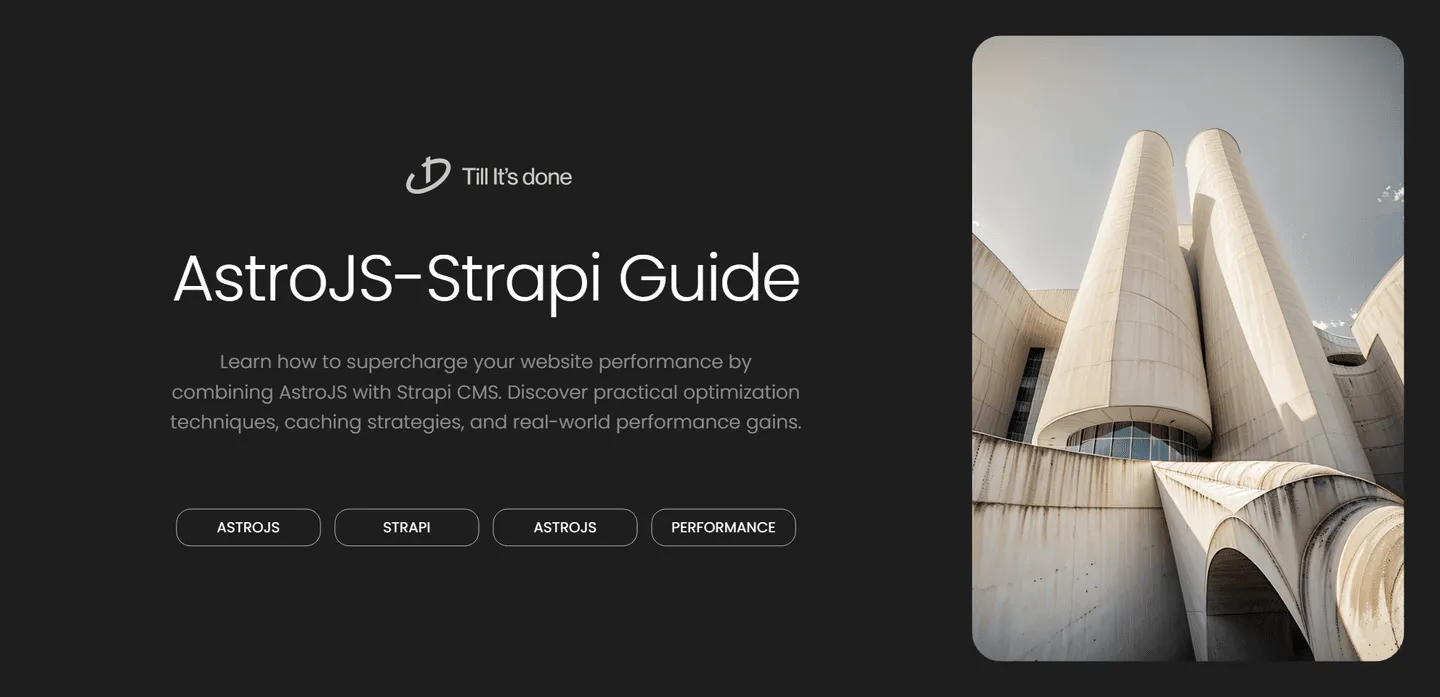- Services
- Case Studies
- Technologies
- NextJs development
- Flutter development
- NodeJs development
- ReactJs development
- About
- Contact
- Tools
- Blogs
- FAQ
Optimize AstroJS & Strapi for Peak Performance
Discover practical optimization techniques, caching strategies, and real-world performance gains.


In today’s digital landscape, website performance isn’t just a nice-to-have – it’s essential for success. As a developer who’s spent countless hours optimizing web applications, I’ve found that combining AstroJS with Strapi as a headless CMS creates a powerful foundation for building lightning-fast websites. Let’s dive into how you can maximize the performance of this dynamic duo.
Understanding the Stack
AstroJS has revolutionized how we build static sites by allowing us to ship zero JavaScript by default, while Strapi gives us the flexibility of a headless CMS. When combined thoughtfully, they create a performance powerhouse that can significantly boost your site’s speed and user experience.

Key Optimization Strategies
1. Content Delivery Optimization
The first step in optimizing your AstroJS and Strapi setup is implementing efficient content delivery. Instead of making API calls on every page load, we can leverage Astro’s static site generation to fetch content during build time. This approach dramatically reduces server load and improves response times.
Here’s what I’ve found works best:
- Pre-fetch and cache Strapi content during build time
- Implement incremental static regeneration for dynamic content
- Use content collections for better organization and type safety
2. Asset Management
When it comes to assets, proper optimization can make or break your site’s performance. I’ve seen significant improvements by:
- Setting up a CDN for Strapi media assets
- Implementing responsive images with srcset
- Using modern image formats like WebP with fallbacks
- Lazy loading images for better initial page load

3. Caching Strategies
Implementing effective caching strategies is crucial for maintaining high performance. Consider:
- Setting up Redis for Strapi API caching
- Utilizing service workers for offline capabilities
- Implementing browser caching with appropriate cache headers
4. Build Process Optimization
The build process itself needs optimization to maintain quick deployment cycles:
- Implement partial builds for content updates
- Use build caching effectively
- Optimize development environment for faster iterations
Advanced Techniques
Going beyond basic optimizations, we can squeeze even more performance by:
- Implementing edge functions for dynamic content
- Using Astro’s middleware for request optimization
- Setting up automated performance monitoring
- Implementing content preloading for critical paths
Real-World Impact
From my experience, implementing these optimizations can lead to:
- 50-80% improvement in First Contentful Paint
- Significant boost in Core Web Vitals scores
- Better SEO rankings due to improved performance
- Reduced server costs through efficient resource utilization

Remember, performance optimization is an ongoing journey, not a destination. Regular monitoring and adjustments based on real user metrics will help maintain and improve your site’s performance over time. By following these strategies and continuously fine-tuning your setup, you’ll create a blazing-fast website that delivers an exceptional user experience.
 สร้างเว็บไซต์ 1 เว็บ ต้องใช้งบเท่าไหร่? เจาะลึกทุกองค์ประกอบ website development cost อยากสร้างเว็บไซต์แต่ไม่มั่นใจในเรื่องของงบประมาณ อ่านสรุปเจาะลึกตั้งแต่ดีไซน์, ฟังก์ชัน และการดูแล พร้อมตัวอย่างงบจริงจาก Till it’s done ที่แผนชัด งบไม่บานปลายแน่นอน
สร้างเว็บไซต์ 1 เว็บ ต้องใช้งบเท่าไหร่? เจาะลึกทุกองค์ประกอบ website development cost อยากสร้างเว็บไซต์แต่ไม่มั่นใจในเรื่องของงบประมาณ อ่านสรุปเจาะลึกตั้งแต่ดีไซน์, ฟังก์ชัน และการดูแล พร้อมตัวอย่างงบจริงจาก Till it’s done ที่แผนชัด งบไม่บานปลายแน่นอน  Next.js สอน 14 ขั้นตอนเบื้องต้น: สร้างโปรเจกต์แรกใน 30 นาที เริ่มต้นกับ Next.js ใน 14 ขั้นตอนเพียงแค่ 30 นาที พร้อม SSR/SSG และ API Routes ด้วยตัวอย่างโค้ดง่าย ๆ อ่านต่อเพื่อสร้างโปรเจ็กต์แรกได้ทันทีที่นี่
Next.js สอน 14 ขั้นตอนเบื้องต้น: สร้างโปรเจกต์แรกใน 30 นาที เริ่มต้นกับ Next.js ใน 14 ขั้นตอนเพียงแค่ 30 นาที พร้อม SSR/SSG และ API Routes ด้วยตัวอย่างโค้ดง่าย ๆ อ่านต่อเพื่อสร้างโปรเจ็กต์แรกได้ทันทีที่นี่  วิธีสมัคร Apple Developer Account เพื่อนำแอปขึ้น App Store ทีละขั้นตอน อยากปล่อยแอปบน App Store ระดับโลก มาอ่านคู่มือสมัคร Apple Developer Account พร้อมเคล็ดลับ TestFlight และวิธีอัปโหลดที่ง่ายในบทความเดียวนี้ได้เลย
วิธีสมัคร Apple Developer Account เพื่อนำแอปขึ้น App Store ทีละขั้นตอน อยากปล่อยแอปบน App Store ระดับโลก มาอ่านคู่มือสมัคร Apple Developer Account พร้อมเคล็ดลับ TestFlight และวิธีอัปโหลดที่ง่ายในบทความเดียวนี้ได้เลย  TypeScript Interface คืออะไร? อธิบายพร้อมวิธีใช้และข้อแตกต่างจาก Type เรียนรู้วิธีใช้ TypeScript Interface เพื่อสร้างโครงสร้างข้อมูลที่ปลอดภัยและเข้าใจง่าย พร้อมเปรียบเทียบข้อดีข้อแตกต่างกับ Type ที่คุณต้องรู้ ถูกรวมเอาไว้ในบทความนี้แล้ว
TypeScript Interface คืออะไร? อธิบายพร้อมวิธีใช้และข้อแตกต่างจาก Type เรียนรู้วิธีใช้ TypeScript Interface เพื่อสร้างโครงสร้างข้อมูลที่ปลอดภัยและเข้าใจง่าย พร้อมเปรียบเทียบข้อดีข้อแตกต่างกับ Type ที่คุณต้องรู้ ถูกรวมเอาไว้ในบทความนี้แล้ว  Material-UI (MUI) คืออะไร อยากสร้าง UI สวยงามและเป็นมืออาชีพในเวลาอันรวดเร็วใช่ไหม มาทำความรู้จักกับ Material-UI (MUI) ที่ช่วยให้คุณพัฒนาแอปพลิเคชันบน React ได้ง่ายและดูดีในทุกอุปกรณ์
Material-UI (MUI) คืออะไร อยากสร้าง UI สวยงามและเป็นมืออาชีพในเวลาอันรวดเร็วใช่ไหม มาทำความรู้จักกับ Material-UI (MUI) ที่ช่วยให้คุณพัฒนาแอปพลิเคชันบน React ได้ง่ายและดูดีในทุกอุปกรณ์  เปรียบเทียบ 3 วิธีติดตั้ง install node js บน Ubuntu: NVM vs NodeSource vs Official Repo แบบไหนดีที่สุด? เรียนรู้วิธีติดตั้ง Node.js บน Ubuntu ด้วย NVM, NodeSource หรือ Official Repo เลือกวิธีที่เหมาะกับความต้องการของคุณ พร้อมเปรียบเทียบ เพื่อการพัฒนาที่มีประสิทธิภาพ!
เปรียบเทียบ 3 วิธีติดตั้ง install node js บน Ubuntu: NVM vs NodeSource vs Official Repo แบบไหนดีที่สุด? เรียนรู้วิธีติดตั้ง Node.js บน Ubuntu ด้วย NVM, NodeSource หรือ Official Repo เลือกวิธีที่เหมาะกับความต้องการของคุณ พร้อมเปรียบเทียบ เพื่อการพัฒนาที่มีประสิทธิภาพ! พูดคุยกับซีอีโอ
We'll be right here with you every step of the way.
We'll be here, prepared to commence this promising collaboration.
Whether you're curious about features, warranties, or shopping policies, we provide comprehensive answers to assist you.


